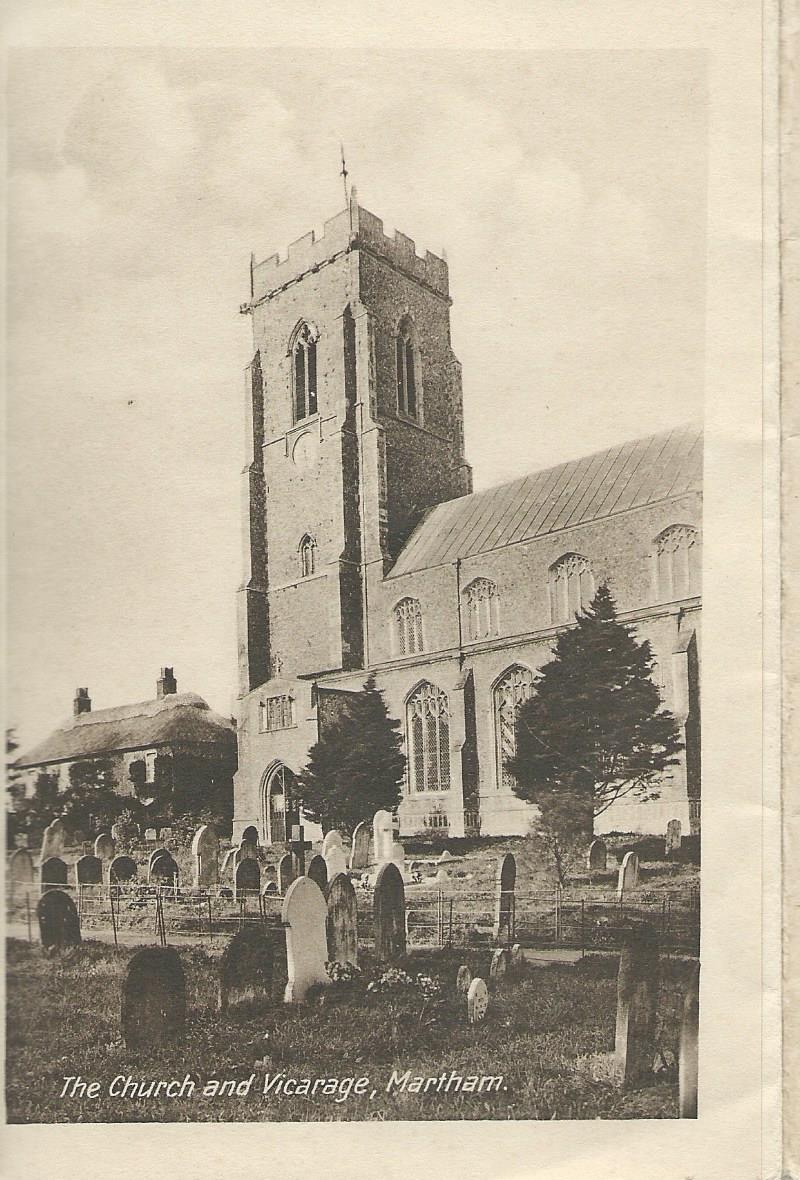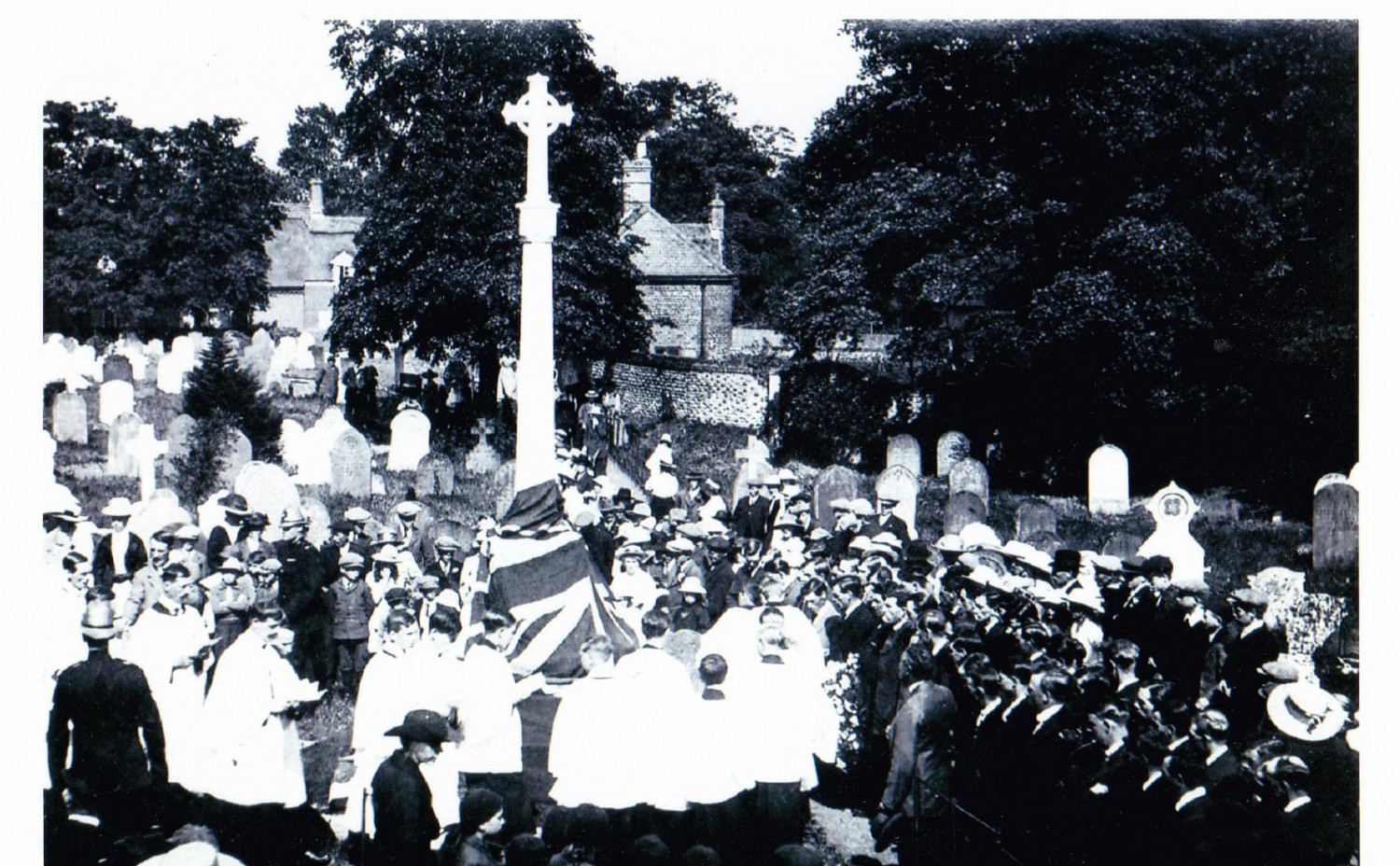
Martham owes much of its identity and character to the Saxons who settled here probably by the end of the 5th century. The name 'Martham' means 'the place where pine martens were found'. It is to those settlers that we owe the structure of our village. They found here numerous spring-fed ponds surrounded by very fertile sandy loam soil ideal for crop growing and an area of less fertile soil ideal for grazing their livestock. Part of the grazing area remains as The Green.
Those settlers were pagans and it is thought that they gathered for worship on the most elevated site in the village - the site of the present Parish Church, dedicated to St. Mary the Virgin. Across the road from the church car park at the entrance to a footpath can be seen a large sarson stone. It is not the sort of stone found in this area, therefore, it is thought that it was brought here to be incorporated in the Saxon worship place.
Soon after St. Augustine arrived in England in in 597 on his mission to convert the pagan people to Christianity, St. Fursey was permitted to build a monastic community at Burgh Castle. That was founded about 640. From there the missionaries must surely have come to Martham and converted the pagan settlers to Christianity. Early Christians were encouraged to gather for worship in the places that had already become worship sites. A wooden preaching cross would have been erected at their meeting place and eventually a simple church would have been built, probably of wood and reed thatch.
A church is mentioned in Domesday Book of 1086 together 50 acres of land to provide to support the parish priest. Before the Norman Conquest of 1066, Martham Manor centred on Martham Hall was held by the Bishop of Elmham. Under the re-organisation which followed the Norman Conquest, Martham Manor became the property of the Bishop of Norwich – Herbert de Losinga. He decided to give part of his land to the de Gunton family, who already held vast estates in Norfolk. The new Manor of Moregrove was thus created and with it the advowson of Martham – the right to appoint the priest to serve the church and community. In 1160 when Roger de Gunton was the Lord of the Manor, he gave the advowson to the Monastery and Priory at Norwich Cathedral on the understanding that after his death, the monks would continue to pray for his soul and the souls of his family and servants. Thus, we find that Martham is under the patronage of Norwich Cathedral and that the Cathedral is one of the bodies responsible for appointing parish priests to Martham. Martham became a ‘Norwich Cathedral Peculiar’. The Priory at Norwich therefore became the Rector of Martham and were entitled to receive the valuable great tithes of the parish.

The magnificent church that you see today was built during two periods. The tower and nave were built between about 1377 and 1480 in the magnificent perpendicular style of that era. In those days the stonemasons (who were extremely skilled men) travelled to wherever work was taking place, leaving their mason’s marks (their signatures) on the stonework. One of these masons left marks on several churches in east Norfolk and became known as ‘The Martham Mason’.
The chancel that was built at that time from 1450 onwards became totally dilapidated and was rebuilt between 1855 and 1861 during the major restoration that took place during those years. The new chancel is a most magnificent example of the gothic revival architecture of that period and included every feature that might have been found in the finest church built before the reformation. The architect was Philip Boyce whose brilliant design was exhibited at the Royal Academy Exhibition of 1856. Martham was one of the first churches in the Norwich Diocese to be re-ordered following the Oxford Movement and the ensuing revival in the Anglican Church.

In 1999 when work on the tower floor was being done to install drainage, the footings of a round tower were exposed indicating that there had been an earlier church on the same site as the present one. That may have been the church mentioned in Domesday Book. It had been thought that the anchoress Olive de Raveningham lived in a small cell attached to the round towered church. There is however considerable uncertainty about this. In the 13th century, when she may have lived, those who felt a vocation to become anchorites made solemn promises in the presence of a priest or bishop, and detailed records of these were kept in the Norwich Diocesan Archives. Olive’s name does not appear among these records. However, she may have been a religious woman fulfilling another role.
Martham was also famous as the burial place of St Blide early in the 11th century. St Blide was the mother of St Walstan and was born about 1075, she was related by marriage to the Royal Family of the House of Wessex. The chapel in Martham Church where she was buried was dedicated in her honour. In 1522 Robert Fullere a tanner of Norwich gave money for repairs to Martham Church ‘where St Blide lyeth’.
The bequest in 1375 of money to Martham Church by the vicar John Spire may have prompted the start of the building of the present church beginning with the tower. John Spire made his will in Latin in 1374. It was translated into English by Barbara Cornford and reads as follows –
“In the name of God Amen. Thursday before the Assumption of the Blessed Mary 1374, I, the said John Spire, Vicar of Martham made my will in the following way – In the first place I leave my soul to God and the Blessed Mary and all the saints, and my body to be buried in the chapel of Saint Blide at Martham………...I leave to the use of that church 10 Marks…”
John Spire died in 1375 having been Vicar of Martham since 1349. Although, in his will, he made other bequests, half of his estate – 10 marks or £6 13s. 4d. (£6.66) being left to Martham Church, however, this would have been insufficient to finance the re-building of the church
A project on the scale of the rebuilding of Martham Church at that time ago would have required a detailed contract to have been drawn up. Contracts from that era have very rarely survived, but as the Priory and Monastery at Norwich Cathedral was the patron of the church it is likely that it was organised from the Cathedral. Their records reveal that their master mason Robert Everard was working on the building of the chancel of Martham Church during the years 1450 to 1480. Another important contributor to the cost of the building may have been local landowner Roger Clarke to whom a stained-glass window was dedicated. This window was not installed after the Victorian restoration.

RECTORS, VICARS and PRIESTS IN CHARGE
Vicars of Martham
1311 Thomas de Langdale
1311 John de Eccles
1321 William de Wicklewood
1323 Roger de K………
1342 Thomas de Halvergate
1349 William de Wardeboys
1349 John Spyre
1378 Andrew Read
1389 William Northales
1392 Robert Tynmouth
1405 John Lanham alias Saltby
1449 William Bishop
1449 Edward Berry
? Robert Allen died 1487
? Thomas Hitton (martyred at Maidstone 1530)
1540 John Harridance died 1559
Robert Foulsham died 1603
1603 Robert Ovington (non-resident)
1603 Robert Lynsey (curate to the above and then vicar.)
1640 John Spendlove
1669 Benjamin Lawrence
1684 Harry Curtis
1694 Richard Marris
1728 James Savage
1758 Thomas Bowman
1792 Paul Whittingham (also Precentor at Norwich Cathedral)
1834 George Pearse
1876 George Merriman
1906 Herbert Webster
1921 Nathaniel Temple Hamlyn (a former Bishop of Accra)
1928 John Herbert Griffiths
1947 William Stenhouse
1954 Harry Kemp
1960 Peter Harry Rye
1968 Ronald Cooling
1976 Edgar Alan Cunnington
Rectors or Priests-in-Charge of the Benefice of Martham, Repps, Thurne & Clippesby.
1990 Peter Paine
2006 Jeanette Crafer
2015 Karen Rayner
2018-2022 Dr. Steven Sivyer
Team Rectors of Flegg Parish Churches.
2023 Dr. Steven Sivyer
